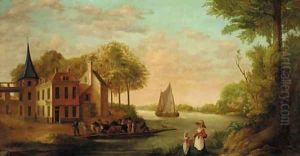Juriaan Andriessen Paintings
Juriaan Andriessen was a Dutch artist born on August 12, 1742, in Amsterdam. He hailed from a family with a strong artistic lineage, as his father, Andries Andriessen, was a painter of church interiors and his brother, Anthonie Andriessen, specialized in painting landscapes.
Juriaan initially trained under his father and later continued his education at the Drawing Academy in Amsterdam, where he was a pupil of the wallpaper painter Jurriaan Buttner. Andriessen developed a specialization in decorative painting, particularly in creating wall and ceiling paintings that were intended to imitate tapestries, silk, and other luxurious materials. These ornate works were popular among the wealthy bourgeoisie of the time, who sought to adorn their homes with the grandeur and opulence that these paintings provided.
His talent for creating these 'behangelschilderijen' (wall paintings) gained him significant recognition and patronage. Andriessen's work often depicted pastoral scenes, cherubs, and mythological figures, incorporating them into elegant architectural frameworks. In addition to his decorative work, he also painted theatre backdrops and worked on restoring paintings, including historical pieces in city halls and churches.
During his lifetime, Juriaan Andriessen was a respected member of the art community in Amsterdam. He was also a teacher, with his most notable pupil being his son, the painter Christiaan Andriessen. Juriaan's legacy continued through his son, who also made significant contributions to Dutch art in his own right.
Juriaan Andriessen's contributions to the decorative arts were characterized by a combination of both Rococo and Neoclassical styles, which were prevalent during his time. He passed away on July 31, 1819, in his birth city of Amsterdam. Today, his works are considered important in the study of Dutch interior decoration and painting of the late 18th and early 19th centuries. Although not as widely known outside of the Netherlands, within his home country, Andriessen's work remains a testament to the skill and artistry of Dutch painters during the period.
